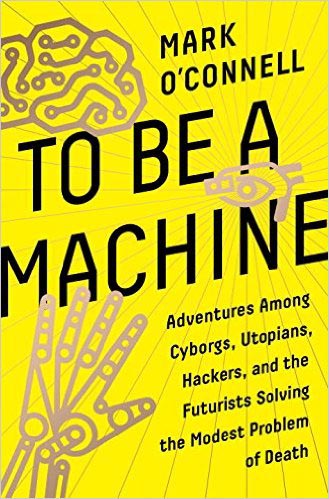In a large warehouse next to the Scottsdale Airport in Arizona, 149 “patients” occupy large cylinders filled with liquid nitrogen. None are alive; some are just decapitated heads. Yet to adherents of the practice called transhumanism, they aren’t dead either, but “suspended” between life and death. When the technology becomes available, the thinking goes, they will, in some shape or form, come back to life.

BOOK REVIEW — “To Be a Machine: Adventures Among Cyborgs, Utopians, Hackers, and the Futurists Solving the Modest Problem of Death,” by Mark O’Connell (Doubleday, 256 pages).
For $200,000, you can have your own body suspended there — or if you opt to have only your brain preserved, the cost is $80,000. The facility in Scottsdale, the Alcor Life Extension Foundation, is one of three cryopreservation sites in the United States. (A fourth is in Russia.)
What if technology could set us free from our own mortal bodies? If there were a way to expand our mental and physical beings beyond the limitations we were born with? If we could harness science to morph our flesh and bones into a machinelike state?
In the transhumanist school of thought, these are not far out propositions. They are our future.
The history, plight, and future of transhumanism are examined in Mark O’Connell’s first book, “To Be a Machine: Adventures Among Cyborgs, Utopians, Hackers, and the Futurists Solving the Modest Problem of Death.” O’Connell, a Slate book columnist and staff writer for the literary website The Millions, defines transhumanism as a “total emancipation from biology itself.” In this thoughtful and readable book, he aims to understand the motivations of those who are guided by the belief that technology will enable humans to transcend the human condition.
In an attempt to explore what it means to think of ourselves as machines, O’Connell takes readers on an all-encompassing tour, meeting artificial intelligence researchers, philosophers, brain-uploading scientists, roboticists with the Defense Advanced Research Projects Agency, and “grinders” (people who implant cybernetic devices into their own skin). He closes with his travels on “the immortality bus” with Zoltan Istvan, a transhumanist author and entrepreneur who ran for president in 2016 on the Transhumanist Party ticket. (He didn’t make a dent in the election, but he claimed that winning was not the point — he wanted to bring awareness to the concept of conquering death with technology, as he reported to Inverse). O’Connell touches on concepts like the singularity — the moment when artificial intelligence surpasses human intelligence — along with mind uploading, life extension, and space colonization. He writes in an agreeable, conversational tone, offering his opinions, doubts, and fears along the way.
O’Connell makes it clear that he does not fit into the subcultures he observes: “In no sense was I among my people. In no sense was this my world.” As a self-proclaimed “interloper,” he connects directly with readers who may know next to nothing about AI, but worry about its implications. Often he closes these sections with reflections about his own uneasy relationship with machines: “The effects of technology on my own life … were something about which I was profoundly ambivalent; for all I had gained in convenience and ‘connectedness,’ I was increasingly aware of the extent to which my movements in the world were mediated and circumscribed by corporations whose only real interest was in reducing the lives of human beings to data, as a means to further reducing us to profit.”
The flip side of creating machinelike humans is creating humanlike machines, and O’Connell is equally fascinated by the astounding but fraught recent strides in artificial intelligence. He visits the Machine Intelligence Research Institute in Berkeley, California, to understand why “AI safety” has become a pressing issue. While the existential dangers of AI may seem a far-off concern, they are a preoccupation for many Silicon Valley elites, with billions in research funding from tech icons like Elon Musk and giants like Facebook and Microsoft. O’Connell observes the DARPA robotics challenge to see just how far robots have evolved, what they are capable of, and what their creators envision for the future.
If transhumanism is the core subject of this book, O’Connell’s explorations of artificial superintelligence and high-tech robotics come off as somewhat confusing detours. Transhumanism, it should be stressed, is one subset of AI — not the other way around. Nick Bostrom, one of the most vocal proponents of investing in research to develop “safe” AI, would likely distance himself from transhumanism, as would many computer scientists and traditional AI researchers. Even within transhumanist thought, there are divides. O’Connell does not fully investigate them.
O’Connell tries to understand the extreme branches of transhumanism that would turn brains and bodies into virtual machines. But not all transhumanists go so far. There’s a spectrum, and some of the most pressing ethical and scientific dilemmas may lie within it. What does it mean to be half human, half machine, for instance? If we could live longer by using technology to replace parts of our aging, dying bodies, would we? What about fixing certain parts of the brain with artificial replacements? Where is the line? What about the concept of Google Glass, the failed tool intended to literally attach to our line of vision, giving us intelligence in real time? These questions are current and relevant, and it would have been interesting to see O’Connell engage them in more depth.
O’Connell plays into the presumed fears of readers. While he is sympathetic to the pursuit of a post-human condition, he displays his own doubts. He occupies a safe space, an “us versus them” world in which “they” are misguided or outside the bounds of normal society. It is easier to look askance at Istvan’s extremely problematic idea of implanting microchips in Syrian refugees, to track their whereabouts and whether they are “contributing to society,” than to explore whether you might choose to have a nonfunctioning piece of your body artificially replaced. It would have been riskier for O’Connell to dig into his own thoughts in this murky space. To resist the temptation to highlight the strangeness of his characters. To wrestle not with why they arrived at their conclusions, but with whether there are merits to these ideas. Or to let the characters speak solely for themselves. Many of these people are highly intelligent, capable, and influential; they deserve due respect for philosophies that lie outside what many consider “normal.”
“To Be a Machine” raises deep religious and philosophical questions. What does it mean to be human? Who are you when your body is part — or all — machine? If you could choose immortality, would you?
As O’Connell himself admits, he “wound up substantially more confused” after writing this book. Many readers will likely experience the same mystification. But perhaps that’s the point.
Hope Reese is a staff writer for TechRepublic, a division of CBS Interactive. She covers the intersection of technology and society, focusing on AI, robotics, and driverless cars.











Comments are automatically closed one year after article publication. Archived comments are below.
Generally, a good commentary but one clear error – Bostrom would definitely not distance himself from transhumanism as he was a co-founder of the World Transhumanist Association (now Humanity+) in 1998.